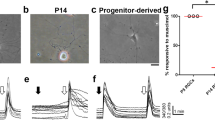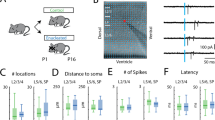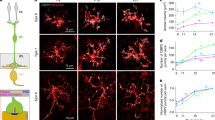Abstract
A FUNDAMENTAL attribute of the vertebrate visual system is the segregation of ON and OFF pathways signalling increments and decrements of light1–4. In the mature retina, dendrites of ON- and OFF-centre retinal ganglion cells (RGCs) stratify in different sublaminae of the inner plexiform layer (IPL), and are differentially innervated by two types of bipolar cells which depolarize and hyperpolarize on exposure to light5–10. This stratification of ON and OFF RGCs is achieved by the gradual restriction of their dendrites which ramify throughout the IPL early in development11–14. The factors underlying this regressive event are unknown. Dendritic stratification occurs around the time that bipolar cells form synapses in the IPL15,16, which raises the possibility that synaptic activity is involved in this process. Here we test this hypothesis by treating the developing cat retina with the glutamate analogue 2-amino-4-phosphonobutyric acid (APR), which hyper-polarizes ON cone bipolar and rod bipolar cells, thereby preventing their release of glutamate17–19. We report that intraocular injection of APB during the period when dendritic stratification normally occurs prevents the formation of structurally segregated ON and OFF retinal pathways. These results provide evidence that glutamate-mediated afferent activity regulates the remodelling of RGC dendrites during development.
This is a preview of subscription content, access via your institution
Access options
Subscribe to this journal
Receive 51 print issues and online access
$199.00 per year
only $3.90 per issue
Buy this article
- Purchase on Springer Link
- Instant access to full article PDF
Prices may be subject to local taxes which are calculated during checkout
Similar content being viewed by others
References
Hartline, H. K. Am. J. Physiol. 121, 400–415 (1938).
Kuffler, S. W. J. Neurophysiol. 16, 37–68 (1953).
Barlow, H. B. J. Physiol. 119, 69–88 (1953).
Schiller, P. H. Trends Neurosci. 15, 86–92 (1992).
Nelson, R. & Kolb, H. Vision Res. 23, 1183–1195 (1983).
Famiglietti, E. V. Jr & Kolb, H. Science 194, 193–195 (1976).
Nelson, R., Famiglietti, E. V. Jr & Kolb, H. J. Neurophysiol. 41, 472–483 (1978).
Wässle, H., Boycott, B. B. & Illing, R. B. Proc. R. Soc. Lond. B212, 177–195 (1981).
McGuire, B. A., Stevens, J. K. & Sterling, P. J. Neurosci. 6, 907–918 (1986).
Wässle, H. & Boycott, B. B. Physiol. Rev. 71, 447–480 (1991).
Maslim, J., Webster, M. & Stone, J. J. comp. Neurol. 254, 382–402 (1986).
Maslim, J. & Stone, J. Devl Br. Res. 44, 87–93 (1988).
Ramoa, A. S., Campbell, G. & Shatz, C. J. J. Neurosci. 8, 4239–4261 (1988).
Dann, J. F., Buhl, E. H. & Peichl, L. J. Neurosci. 8, 1485–1499 (1988).
Maslim, J. & Stone J. Brain Res. 373, 35–48 (1986).
Maslim, J. & Stone J. Devl Br. Res. 44, 87–93 (1988).
Slaughter, M. M. & Miller, R. F. Science 211, 182–185 (1981).
Bolz, J., Wässle, H. & Thier, P. Neurosci. 12, 875–885 (1984).
Müller, F., Wässle, H. & Voigt, T. J. Neurophysiol. 59, 1657–1672 (1988).
Wässle, H., Boycott, B. B. & Illing R. B. Proc. R. Soc. Lond. B 212, 177–195 (1981).
Kolb, H. & Famiglietti, E. V. Science 186, 47–49 (1974).
Famiglietti, E. V. & Kolb, H. Brain Res. 84, 293–300 (1975).
McGuire, B. A., Stevens, J. K. & Sterling, P. J. Neurosci. 4, 2920–2938 (1984).
McGuire, B. A., Stevens, J. K. & Sterling, P. J. Neurosci. 6, 907–918 (1986).
Wässle, H., Yamashita, M., Greferath, U., Grünert, U. & Müller, F. Vis. Neurosci. 7, 99–112 (1991).
Movshon, J. A. & van Sluyters, R. C. A. Rev. Psychol. 32, 477–522 (1981).
Sherman, S. M. & Spear, P. D. Physiol. Rev. 62, 740–855 (1982).
Shatz, C. J. & Stryker, M. P. Science 242, 87–89 (1988).
Sretavan, D. W., Shatz, C. J. & Stryker, M. P. Nature 336, 468–471 (1988).
Shatz, C. J. Neuron 5, 745–756 (1990).
Hahm, J. O., Langdon R. B. & Sur, M. Nature 351, 568–570 (1991).
Wong, R. O. L., Herrmann, K. & Shatz, C. J. J. Neurobiol. 22, 685–697 (1991).
Dubin, M. W., Stark, L. A. & Archer, S. M. J. Neurosci. 6, 1021–1036 (1986).
Leventhal, A. G. & Hirsch, H. V. B. J. Neurosci. 3, 332–344 (1983).
Lau, K. C., So, K. F. & Tay, D. J. comp. Neurol. 300, 583–592 (1990).
Author information
Authors and Affiliations
Rights and permissions
About this article
Cite this article
Bodnarenko, S., Chalupa, L. Stratification of ON and OFF ganglion cell dendrites depends on glutamate-mediated afferent activity in the developing retina. Nature 364, 144–146 (1993). https://doi.org/10.1038/364144a0
Received:
Accepted:
Issue Date:
DOI: https://doi.org/10.1038/364144a0
This article is cited by
-
Dendritic and axonal targeting patterns of a genetically-specified class of retinal ganglion cells that participate in image-forming circuits
Neural Development (2014)
-
Activity-dependent disruption of intersublaminar spaces and ABAKAN expression does not impact functional on and off organization in the ferret retinogeniculate system
Neural Development (2011)
-
Age and Visual Experience-dependent Expression of NMDAR1 Splice Variants in Rat Retina
Neurochemical Research (2011)
-
Activity acts locally
Nature (2009)
-
Ectopic synaptic ribbons in dendrites of mouse retinal ON- and OFF-bipolar cells
Cell and Tissue Research (2009)
Comments
By submitting a comment you agree to abide by our Terms and Community Guidelines. If you find something abusive or that does not comply with our terms or guidelines please flag it as inappropriate.



